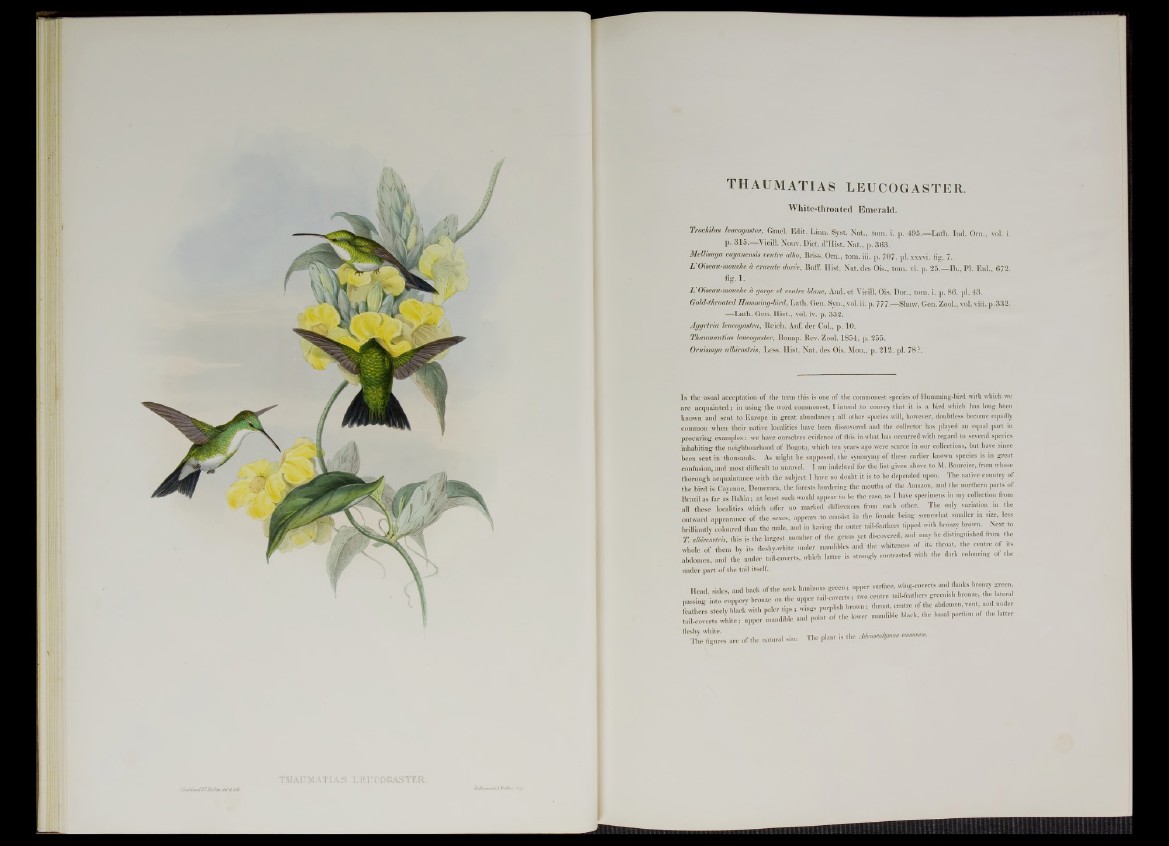
Goulda/uLMCRCchUr, MetUth
THAUMATIAS LEFCOCASTE
THAUMATIAS LEUCOGASTER.
White-throated Emerald.
Trochilm lemogaster, Gmel. Edit. Linn. Syst. Nat., tom. i. p. ¿DbM i -H . In d. Om., vol. i.
p. 315.—Vieiil. Nouv. Diet. d’IIist. Nat., p. 363.
Mellùmga caganensis ventre albo, Briss. Om., torn. iii. p. 707. pl. xxxvi. fig. 7.
L ’Oiseau-mouche à cravate dorée, Buff. Hist. Nat. des Ois., tom. vi. p. 2 5 S I b . , Pl. Enl., 672.
fig. 1.
L'Oiseau-mouche à gorge et ventre blanc, Aud. et Vieil! Ois. Dor., torn. i. p. 86. pl. 43.
Gold-throated Humming-bird, Lath. Gen. Syn., vol. ii. p. 777.—Shaw, Gen. Zool., vol. viii. p. 332.
— La th. Gen. Hist., vol. iv. p. 332.
Agyrtria leucogastra, Reich. Auf. der Col., p. 10.
Thaumantias leucogaster, Bonap. Rev. Zool. 1854, p. 255.
Ornismya albirostris, Less. Hist. Nat. des Ois. Mou., p. 212. pl. 78?.
In the usual acceptation o f the term this is one of the commonest species of Humming-bird with which we
are acquainted; in using the word commonest, I intend to convey that it is a bird which has long been
known and sent to Europe in great abundance; all other species will, however, doubtless become equally
common when their native localities have been discovered and the collector has played an equal part in
procuring examples: we have ourselves evidence of this in what has occurred with regard to several species
inhabiting the neighbourhood of Bogota, which ten years ago were scarce in our collections, but have since
been sent in thousands. As might be supposed, the synonymy of these earlier known species is in great
confusion, and most difficult to unravel. I am indebted for the list given above to M. Bourcier, from whose
thorough acquaintance with the subject X have no doubt it is to be depended upon. The native country of
the bird is Cayenne, Demerara, the forests bordering the mouths of the Amazon, and the northern parts of
Brazil as far as Bahia; at least such would appear to be the case, as I have specimens in my collection from
nil these localities which offer no marked differences from each other. The only variation in the
outward appearance of the sexes, appears to consist in the female being somewhat smaller in size, less
brilliantly coloured than the male, and in having the outer tail-feathers tipped with bronzy brown Next to r. albkemtris this is the largest member of the genus yet discovered, and may be distinguished from the
whole of them by its fleshy-white under mandibles and the whiteness of its throat the centre of its
abdomen, and the under tail-coverts, which latter is strongly contrasted with the dark colouring of the
under part of the tail itself.
Head, sides, and back of the neck luminous green I upper surface, wing-coverts and flanks bronzy green
passing into coppery bronze on the npper tail-coverts; two centre tail-passing into pp y ^ ^ fea thoef r,;hi eg raebednoimshe Dbir ovnezoetj, tahned l„antedrearl
“ e i t wiiite; upper mandible and point of the lower mandible black, the basal portion of the latter
fle! e f o T r e s are of the natural size. The plant is the Ademcahjum coamurn.